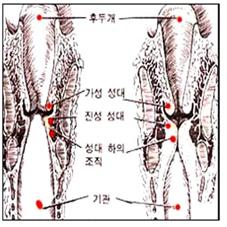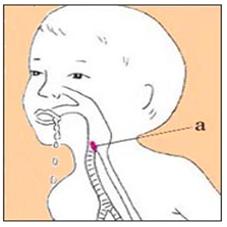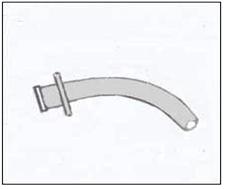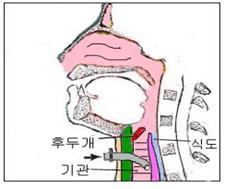급성 후두개염으로 인한 크루프, Croup caused by acute epiglottitis
| 급성 후두개염으로 생긴 크루프의 원인 |
- B형 헤모필러스 인플루엔자균([부모도 반의사가 되어야 한다-소아가정간호백과]-제 7권 소아 청소년 감염병-B형 헤모필러스 인플루엔자균(히비 균, Hib bacteria) 감염에 의한 감염병 참조) 이란 박테리아가 이 병을 주로 일으킨다.
- 드물게 폐렴연쇄상구균이나 A군 베타 용혈성 연쇄상구균이 후두에 감염되어 급성 박테리아 감염성 후두개염이 생기고 그로 인해 크루프가 생길 수 있다. 편의상 여기서 B형 헤모필러스 인플루엔자균을 B형 인플루엔자균(히비균/Hib bacteria)이라 칭한다. B형 인플루엔자균이 후두개에 감염되어 생긴 급성 후두개염을 급성 히비 박테리아 후두개염이라고 한다. 그냥 급성 박테리아 후두개염이라고도 한다.
- 급성 박테리아 후두개염으로 인해 급성 크루프가 생긴다. B형 인플루엔자균이 후두개에도 감염되고 후두개 바로 위로 연결되어 있는 인두, 후두개가 붙어 있는 후두 전체, 후두 기도 아래로 연결되어 있는 기관에까지 감염될 수 있다. 그 후두와 후두의 상하에 있는 기도까지 감염이 급성으로 퍼질 수 있다.
| 급성 후두개염으로 생긴 크루프의 증상 징후 |
- B형 인플루엔자균 감염으로 생긴 급성 박테리아 후두개염에 의한 크루프의 증상징후는 바이러스 감염으로 생긴 급성 후두염의 크루프의 증상 징후에 비해 훨씬 더 심하다.
- 이 병이 발병되면 독성 상태에 빠진다.
- 급성 박테리아 후두개염에 걸리면 생명이 위험하다.
- 삽시간에 호흡곤란이 아주 심하게 생기면서 침을 삼키지 못해 흘린다.
- 금방 숨이 넘어갈 듯 하면서 금방 죽을 것 같이 심히 앓는 것이 보통이다.
- 그림 91에서 화살표로 표시된 부분이 후두개이다.
- 이 병이 시작된 후 불과 몇 분 내지 몇 시간 이내에 갑자기 목안이 몹시 아프면서 심하게 목이 쉰다. 39~40℃ 정도 고열이 나고 심한 호흡곤란이 생긴다.
- 의사나 간호사가 아닌 비 의료인들이 보아도 죽을병에 걸려 심히 앓고 있는 것을 쉽게 짐작할 수 있을 정도로 심하게 앓는다.
- 초기에는 후두개에만 화농성 염증이 생길 수 있지만 삽시간에 인두, 후두, 기관, 후두개 주위 까지 화농성 염증이 번지고 후두 전체와 후두개가 부어서 그 후두 기도 속이 점점 더 좁아지면서 호흡곤란이 점점 더 심해진다.
- 이 때 숨을 제대로 쉴 수 없기 때문에 안절부절못하면서 목과 얼굴을 앞으로 쑥 내밀고 혀를 입 밖으로 내밀고 침을 질질 흘릴 수 있다.
- 이런 상태가 점점 더 심해지면서 얼굴이 창백해지고 피부가 파랗게 질릴 수 있다.
- 이 때 목안 어디가 아픈가 알아보기 위해 입을 벌리고 목안을 살펴보다가 부었던 후두개가 갑자기 후두 기도부분을 꼭 막아 질식 사망할 수 있다.
- 숨을 들이 마시고 쉴 때 흡기 협착음이 생기고, 앞가슴의 늑골 사이에 있는 늑골 근육들이 흉강 속으로 빨려들어 갔다 나왔다 할 수 있다.
- 급성 후두개염을 일으킨 B형 헤모필러스 인푸루엔자균이 후두개염과 패혈증을 동시 함께 일으킬 수 있다.

그림 89. 그림 좌-정상 후두.
그림 우-급성 박테리아 감염성 후두개염으로 후두가 부었다. 급성 박테리아 감염성 후두개염으로 호흡 곤란이 생기고 침을 흘리는 증상이 생길 수 있다.
출처: 부모도 반의사가 되어야 한다와 Used with permission from Infectious diseases of children,8th edition.The C.V Mosby Co. Saul Krugman, Samul L Katz and others

그림 90. 급성 박테리아 후두개염이 있을 때 호흡곤란.
빨간색으로 표시된 부분(a)은 후두개이고 거기에 생긴 박테리아 감염을 급성 박테리아 후두개염이라고 한다.
Copyright ⓒ 2011 John Sangwon Lee, MD, FAAP
| 급성 후두개염으로 생긴 크루프의 진단 치료 |
- 앞서 설명한 증상 징후가 나타나면서 급성 크루프가 시작되면 바로 의료구급대나 병원 응급실이나 단골 소아청소년과 의사의 응급 전화 진료 지시에 따라 구급차나 다른 적절한 교통수단으로 가까운 종합 병원 응급실로 급히 데리고 가야 한다. [부모도 반의사가 되어야 한다-소아가정간호백과]-제1권 소아청소년 응급의료-호흡 곤란 참조
- 앞서 설명한 증상 징후가 나타나면서 급성 크루프가 시작되면 바로 의료구급대나 병원 응급실이나 단골 소아청소년과 의사의 응급 전화 진료 지시에 따라 구급차나 다른 적절한 교통수단으로 가까운 종합 병원 응급실로 급히 데리고 가야 한다. [부모도 반의사가 되어야 한다-소아가정간호백과]-제1권 소아청소년 응급의료-호흡 곤란 참조
- 앞서 설명한 증상 징후가 나타나면서 급성 크루프가 시작되면 바로 의료구급대나 병원 응급실이나 단골 소아청소년과 의사의 응급 전화 진료 지시에 따라 구급차나 다른 적절한 교통수단으로 가까운 종합 병원 응급실로 급히 데리고 가야 한다. [부모도 반의사가 되어야 한다-소아가정간호백과]-제1권 소아청소년 응급의료-호흡 곤란 참조
- 병력, 증상 징후, 진찰소견 등을 종합해서 이 병이 의심되면 목과 가슴 X-선 사진·목과 인두 후두 기관 초음파 검사, 피검사, 세균배양검사 등으로 비교적 쉽게 진단할 수 있다.
- 심할 때는 목과 가슴 X-선 사진을 찍어 확진 할 여유도 없다. 또 이 병에 걸린 환아를 병원으로 데리고 가는 도중이나, 목안을 들여다보고 진찰을 하는 중 곪고 부은 후두개가 후두 기도 부분을 갑자기 꼭 막아서 질식 사망할 수 있다.
- 이 병이 의심되면 언제든지 기관내관 삽입을 응급으로 즉시 할 수 있고, 또 기관 절개수술을 응급으로 언제든지 즉시 할 수 있는 종합 병원의 수술실 수술대 위에서 진찰 진단 치료를 동시 하는 것이 이 병의 진단 치료의 원칙이다.
- 수술실에서 후두경이나 후두 내시경으로 후두를 직접 들여다보고 진단하면서 필요에 따라 기관 절개 개구 수술로 만든 인공 기도를 통해 숨을 쉬게 치료 해 주든지, 기관 내 삽입관을 통해 숨을 쉬게 하는 치료를 한다. 나이, 중증도, 합병증의 유무에 따라 이 병을 달리 치료할 수도 있다.
- 포도당 전해질용액 정맥주사로 탈수를 예방하고 치료한다.
- 세포택심(Cefotaxime), 세프트리액손(Ceftriaxone), 클로램페니콜과 앰피실린이나 그밖에 다른 적절한 항생제 중 한두 가지 항생제 정맥주사로 치료 한다.
- 기관 내 삽입 관 튜브로 치료를 할 때는 치료 결과에 따라 적절한 시기에 기관 내 삽입 관을 빼고 정상 상하 기도로 호흡하게 한다.
- 기관 절개수술과 기관 내 삽입관을 통해 임시 숨 쉬게 치료할 때는 그 기관 내 삽입 관 숨구멍을 통해서 수증기와 산소를 공급한다.
- 이렇게 3~4일 정도 적극적으로 치료하면 급성 후두개염의 대부분은 잘 낫는다.
- 후두개염이 다 나은 후 기관 절개수술과 기관 내 삽입 관 숨구멍을 수술로 막아준다. 그리고 적어도 10일 간 적절한 항생제로 치료한다.
- 요즘 디프테리아로 인한 크루프는 거의 볼 수 없는 감염병이다. 또 B형 인플루엔자균 감염에 의한 후두개염으로 인한 크루프도 보기 드문 감염병이다.
- B형 인플루엔자균 감염에 의한 감염병을 예방할 수 있는 예방접종 백신으로 적절히 잘 접종하면 이 병에 걸리지 않는다. [부모도 반의사가 되어야 한다-소아가정간호백과]-제 7권 소아 청소년 감염병-B형 헤모필러스 인플루엔자균에 의한 감염병의 예방 참조

그림 92. 기관 절개 개구 삽입관(Cannula 캐뉼라).
Copyright ⓒ 2011 John Sangwon Lee, MD., FAAP

그림 93.기관 절개 개구 삽입관이 기관 속에 삽입되어 있다
a-식도, b-기관, c-후두개
화살표로 가리킨 삽입관을 통해 숨 쉬는 대로 산소나 공기가 기도 속으로 들어가고 나온다.
Copyright ⓒ 2011 John Sangwon Lee, MD., FAAP
Croup caused by acute epiglotitis
Causes of croup from acute epiglottitis
• Haemophilus influenzae type B ([Parents should also become at least the half-doctors – Encyclopedia of Pediatric and Home Nursing] – Volume 7 Infectious Diseases in Children and Adolescents – Infectious Diseases Caused by Haemophilus Influenza Type B (Hib bacteria) bacteria mainly cause the disease.
• Rarely, streptococcus pneumococcus or group A beta-hemolytic streptococcus can infect the larynx, resulting in acute bacterial infectious epiglottis, resulting in croup. For convenience, Haemophilus influenzae type B is referred to herein as influenza type B (Hib bacteria).
Acute epiglottitis caused by influenza B infection in the epiglottis is called acute hib- bacterial epiglottis. Also called acute bacterial epiglottitis.
• Acute bacterial epiglottitis causes acute croup. Influenza B bacteria can also infect the epiglottis and infect the pharynx directly above the epiglottis, the entire larynx to which the epiglottis is attached, and even the organs connected below the larynx airway. The infection can spread acutely to the larynx and the airways above and below the larynx. Symptoms of croup from acute epiglottitis
• Symptoms of croup caused by acute bacterial epiglottitis caused by influenza B infection are much more severe than those of croup of acute laryngitis caused by viral infection.
• When the disease develops, it becomes toxic.
• Acute bacterial epiglottitis is life-threatening.
• Shortly thereafter, I have severe shortness of breath and I can’t swallow saliva.
• It is common to be so ill that you feel like you are going to die soon.
• The part indicated by the arrow in Figure 91 is the epiglottis.
• Sudden, severe sore throat and severe hoarseness within minutes or hours of the onset of the disease. I have a high fever of about 39-40℃ and severe shortness of breath.
• People who are not doctors or nurses are so badly ill that they can easily guess that they are seriously ill from a fatal disease.
• In the beginning, only the epiglottis may develop suppurative inflammation, but the suppurative inflammation quickly spreads to the pharynx, larynx, trachea and epiglottis. • Because you cannot breathe properly at this time, you may feel restless, sticking your neck and face forward, sticking your tongue out of your mouth, and drooling.
• As this condition gets worse, your face may turn pale and your skin may turn blue.
• At this time, the epiglottis, which was swollen while opening the mouth and examining the throat to see if there is any pain in the throat, can suddenly block the larynx airway and cause suffocation.
• Inspiratory stenosis is produced when breathing in and out, and the rib muscles between the ribs of the chest are sucked into and out of the chest cavity.
• Haemophilus influenzae type B, which caused acute epiglottitis, can cause epiglottitis and sepsis at the same time.

Figure 89. Figure left-normal larynx.
Fig. Right – Swollen larynx due to acute bacterial infectious epiglottis.
Acute bacterial infectious epiglottitis can cause shortness of breath and drooling.
Source: Parents Should Be Anti-Conscientious and Used with permission from Infectious diseases of children, 8th edition.
The C.V Mosby Co. Saul Krugman, Samul L Katz, and others

Figure 90. Dyspnea in the presence of acute bacterial epiglottitis. The area marked in red (a) is the epiglottis, and the bacterial infection there is called acute bacterial epiglottis. Copyright ⓒ 2011 John Sangwon Lee, MD, FAAP
Diagnosis and treatment of croup due to acute epiglottitis
• When acute croup begins with the symptoms described above, immediately take them to the nearest general hospital emergency room by ambulance or other appropriate means of transportation according to the medical emergency department, hospital emergency room, or emergency phone call instructions from a regular pediatrician. [Parents should also become anti-doctors – Encyclopedia of Pediatric and Family Nursing] – Refer to Volume 1 Emergency Medical Care for Children and Adolescents – Dyspnea
• When acute croup begins with the symptoms described above, immediately take them to the nearest general hospital emergency room by ambulance or other appropriate means of transportation according to the medical emergency department, hospital emergency room, or emergency phone call instructions from a regular pediatrician. [Parents should also become at least the half-doctors – Encyclopedia of Pediatric and Family Nursing] – Refer to Volume 1 Emergency Medical Care for Children and Adolescents – Dyspnea
• When acute croup begins with the symptoms described above, immediately take them to the nearest general hospital emergency room by ambulance or other appropriate means of transportation according to the medical emergency department, hospital emergency room, or emergency phone call instructions from a regular pediatrician.
[Parents should also become at least the half-doctors – Encyclopedia of Pediatric and Family Nursing] – Refer to Volume 1 Emergency Medical Care for Children and Adolescents – Dyspnea• If the disease is suspected by combining the medical history, symptom signs, and examination findings, it is relatively easy to diagnose with X-rays of the neck and chest, ultrasound examination of the neck and pharynx and larynx, blood tests, and bacterial culture tests.
• In severe cases, there is no time to confirm the diagnosis by taking X-rays of the neck and chest. In addition, while taking a child with this disease to the hospital, or while looking into the throat and examining the patient, a swollen and swollen epiglottis suddenly clogs the larynx and airway, leading to death by suffocation.
• The principle of diagnosis and treatment of this disease is to perform diagnosis and treatment at the same time on the operating table of the operating room of a general hospital, where endotracheal tube insertion can be performed immediately as an emergency and tracheostomy can be performed immediately as an emergency whenever this disease is suspected. am.
• In the operating room, directly examine and diagnose the larynx with a laryngoscope or laryngoscope, and if necessary, provide breathing treatment through an artificial airway made by tracheostomy opening surgery or breathing through an endotracheal tube. Depending on the age, severity, and presence of complications, the disease may be treated differently.
• Prevention and treatment of dehydration by intravenous injection of glucose electrolyte solution.
• Treatment with Cefotaxime, Ceftriaxone, chloramphenicol and one or two antibiotics such as ampicillin or other appropriate antibiotics intravenously.
• When treating with an endotracheal tube, the tube is withdrawn at an appropriate time depending on the results of the treatment, and breathing through normal upper and lower airways.
• During tracheostomy and temporary breathing treatment through an endotracheal tube, water vapor and oxygen are supplied through the endotracheal tube pore.
• If you actively treat this for 3 to 4 days, most cases of acute epiglottitis will be cured.
• After the epiglottis has healed, tracheostomy and endotracheal cannulation are closed with surgery. and treated with appropriate antibiotics for at least 10 days.
• Croup caused by diphtheria is a rare infectious disease these days. Also, croup caused by epiglottitis caused by influenza B infection is a rare infectious disease. • If you are properly vaccinated with a vaccine that can prevent infectious diseases caused by influenza B infection, you will not get this disease.
[Parents should also become at least the half-doctors-Children and Family Nursing Encyclopedia]-Volume 7 Infectious Diseases in Children and Adolescents-See Prevention of Infectious Diseases Caused by Haemophilus Influenza Type B
Figure 92. Tracheostomy orifice cannula (Cannula cannula). Copyright ⓒ 2011 John Sangwon Lee, MD., FAAP

Figure 93. Tracheostomy opening The cannula is inserted into the trachea a – esophagus, b – trachea, c – epiglottis Oxygen or air enters and leaves the airways as you breathe through the cannula indicated by the arrow. Copyright ⓒ 2011 John Sangwon Lee, MD., FAAP
출처 및 참조 문헌 Sources and references
- NelsonTextbook of Pediatrics 22ND Ed
- The Harriet Lane Handbook 22ND Ed
- Growth and development of the children
- Red Book 32nd Ed 2021-2024
- Neonatal Resuscitation, American Academy Pediatrics
- www.drleepediatrics.com 제1권 소아청소년 응급 의료
- www.drleepediatrics.com 제2권 소아청소년 예방
- www.drleepediatrics.com 제3권 소아청소년 성장 발육 육아
- www.drleepediatrics.com 제4권 모유,모유수유, 이유
- www.drleepediatrics.com 제5권 인공영양, 우유, 이유식, 비타민, 미네랄, 단백질, 탄수화물, 지방
- www.drleepediatrics.com 제6권 신생아 성장 발육 육아 질병
- www.drleepediatrics.com제7권 소아청소년 감염병
- www.drleepediatrics.com제8권 소아청소년 호흡기 질환
- www.drleepediatrics.com제9권 소아청소년 소화기 질환
- www.drleepediatrics.com제10권. 소아청소년 신장 비뇨 생식기 질환
- www.drleepediatrics.com제11권. 소아청소년 심장 혈관계 질환
- www.drleepediatrics.com제12권. 소아청소년 신경 정신 질환, 행동 수면 문제
- www.drleepediatrics.com제13권. 소아청소년 혈액, 림프, 종양 질환
- www.drleepediatrics.com제14권. 소아청소년 내분비, 유전, 염색체, 대사, 희귀병
- www.drleepediatrics.com제15권. 소아청소년 알레르기, 자가 면역질환
- www.drleepediatrics.com제16권. 소아청소년 정형외과 질환
- www.drleepediatrics.com제17권. 소아청소년 피부 질환
- www.drleepediatrics.com제18권. 소아청소년 이비인후(귀 코 인두 후두) 질환
- www.drleepediatrics.com제19권. 소아청소년 안과 (눈)질환
- www.drleepediatrics.com 제20권 소아청소년 이 (치아)질환
- www.drleepediatrics.com 제21권 소아청소년 가정 학교 간호
- www.drleepediatrics.com 제22권 아들 딸 이렇게 사랑해 키우세요
- www.drleepediatrics.com 제23권 사춘기 아이들의 성장 발육 질병
- www.drleepediatrics.com 제24권 소아청소년 성교육
- www.drleepediatrics.com 제25권 임신, 분만, 출산, 신생아 돌보기
- Red book 29th-31st edition 2021
- Nelson Text Book of Pediatrics 19th- 21st Edition
- The Johns Hopkins Hospital, The Harriet Lane Handbook, 22nd edition
- 응급환자관리 정담미디어
- Pediatric Nutritional Handbook American Academy of Pediatrics
- 소아가정간호백과–부모도 반의사가 되어야 한다, 이상원 저
- The pregnancy Bible. By Joan stone, MD. Keith Eddleman, MD
- Neonatology Jeffrey J. Pomerance, C. Joan Richardson
- Preparation for Birth. Beverly Savage and Dianna Smith
- 임신에서 신생아 돌보기까지. 이상원
- Breastfeeding. by Ruth Lawrence and Robert Lawrence
- Sources and references on Growth, Development, Cares, and Diseases of Newborn Infants
- Emergency Medical Service for Children, By Ross Lab. May 1989. p.10
- Emergency care, Harvey Grant and Robert Murray
- Emergency Care Transportation of Sick and Injured American Academy of Orthopaedic Surgeons
- Emergency Pediatrics A Guide to Ambulatory Care, Roger M. Barkin, Peter Rosen
- Quick Reference To Pediatric Emergencies, Delmer J. Pascoe, M.D., Moses Grossman, M.D. with 26 contributors
- Neonatal resuscitation Ameican academy of pediatrics
- Pediatric Nutritional Handbook American Academy of Pediatrics
- Pediatric Resuscitation Pediatric Clinics of North America, Stephen M. Schexnayder, M.D.
-
Pediatric Critical Care, Pediatric Clinics of North America, James P. Orlowski, M.D.
-
Preparation for Birth. Beverly Savage and Dianna Smith
-
Infectious disease of children, Saul Krugman, Samuel L Katz, Ann A.
- 제4권 모유, 모유수유, 이유 참조문헌 및 출처
- 제5권 인공영양, 우유, 이유, 비타민, 단백질, 지방 탄수 화물 참조문헌 및 출처
- 제6권 신생아 성장발육 양호 질병 참조문헌 및 출처
- 소아과학 대한교과서
Copyright ⓒ 2014 John Sangwon Lee, MD., FAAP
“부모도 반의사가 되어야 한다”-본 사이트의 내용은 여러분들의 의사로부터 얻은 정보와 진료를 대신할 수 없습니다.
“The information contained in this publication should not be used as a substitute for the medical care and advice of your doctor. There may be variations in treatment that your doctor may recommend based on individual facts and circumstances.
“Parental education is the best medicine.”